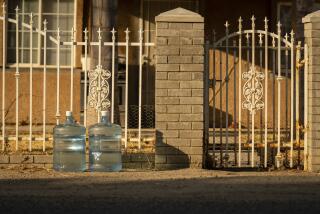Poseidon’s Huntington Beach desalination plant still in choppy waters

As Poseidon Water pursues the final government approvals needed to build one of the country’s biggest seawater desalination plants, the company still cannot definitively say who will buy the 50 million gallons a day of drinking water it wants to produce on the Orange County coast.
That’s one of several questions that continue to dog the $1-billion Huntington Beach project as Poseidon tries to seal an ironclad deal more than two decades after it first proposed the ocean desalter.
During two long days of online hearings last week, a regional board that is about to vote on a key Poseidon permit challenged proponents on a number of fronts.
Board members asked whether Orange County needs the costly supply. They questioned the use of 17-year-old data in gauging the plant’s potential harm to marine life. And they expressed doubts about whether Poseidon’s wetland restoration plans meet state environmental requirements to offset that harm.
While it is doubtful that the Santa Ana Regional Water Quality Control Board will deny the permit when it continues the hearing Friday, the panel’s skepticism could further slow the much-delayed project. The private company faces still more hurdles at the California Coastal Commission, its next stop after the water board.
During its long quest for approval, Poseidon has cultivated political support with lobbying, campaign contributions and the lure of drought-proof water supplies. Its promise of several thousand construction jobs and new tax revenue has rallied labor support.
But environmental groups have fought the company, arguing that it is privatizing a public resource and has failed to adapt an old proposal to new state ocean protections.
Backers have pitched ocean desalination as an inexhaustible, local supply for a region that imports much of its water from increasingly unreliable, distant sources. Yet the Huntington Beach project has been unable to shake criticisms that Poseidon is trying to fill a need that doesn’t exist.
“How can you tell us you have an identified need for water when what you’re going to do with it is entirely speculative?” regional water board member Daniel Selmi asked an official of the Orange County Water District, Poseidon’s prospective customer.
Board vice chair William von Blasingame previously raised similar concerns. “It looks like you guys kind of want to go out and see where you can find a home for this water. And it doesn’t seem like you have a home,” he said at a May workshop.
Need is one of the aspects that regional water boards are required under state law to consider when reviewing plans to construct desalination facilities on the California coast. It factors into the size and location of a project — and thus its impact on the marine environment.
During last week’s hearing, Von Blasingame expressed frustration that the Orange County agency has signed only a nonbinding term sheet to buy the plant’s annual deliveries of 56,000 acre-feet of scrubbed seawater. (One acre-foot typically serves two to three Southern California households a year.)
“This says you can walk away. … It seems like you’re giving yourself an out,” he said.
District officials say they can’t sign a final purchase agreement with Poseidon until they know the price of the water, and Poseidon says it can’t provide a definite price until it has obtained all the necessary permits.
The company has also made it clear that it won’t build the Huntington Beach plant — its second big coastal desalter in California after one in Carlsbad — unless it has a firm contract with a public agency to buy all the supplies over the expected 50-year life of the project.
Those supplies will be among the most expensive in the state. At roughly $2,250 an acre-foot, including distribution, the desalted water would be twice as costly as treated imported supplies from the Metropolitan Water District of Southern California.
And if cities don’t step up to buy the Poseidon supplies from the Orange County district, officials say they would inject it into the regional groundwater basin that is the primary source for north and central Orange County residents. That would drive up groundwater costs.
Board members questioned district officials about why they wanted to replace imported deliveries with much more expensive desalinated supplies that would inevitably push up residential and commercial water rates.
Board Chair William Ruh said household water bills were bound to rise more than district estimates of $3 to $6 a month and worried about the impact on working-class families and small businesses.
John Kennedy, executive director of engineering and water resources for the Orange County district, responded that he expects the cost of imported water will catch up with desalination prices in coming years.
More fundamentally, he told the board his agency wants to reduce the county’s reliance on Metropolitan imports from the north, which are subject to cuts related to drought and environmental regulation.
Another stumbling block for Poseidon is state requirements to mitigate the project’s harm to the marine environment.
The company plans to build the desalter on the grounds of the AES Huntington Beach Generating Station, which will soon cease operation, and use the power plant’s exisiting ocean cooling pipes to tap the Pacific.
Poseidon would draw 106 million gallons a day of seawater through the huge offshore intake pipe, which would be screened, and use reverse osmosis membranes to rid the seawater of salt and impurities.
That process would produce 56 million gallons a day of brine concentrate — roughly twice as salty as the ocean — which would be dumped back into the Pacific via a 1,500-foot discharge pipe equipped with outfall diffusers to promote mixing and dilution.
The intake and discharge operations will take a toll on plankton, which plays a crucial role in the marine food chain, killing an estimated 300,000 microscopic organisms a day.
That estimate is based on a 2003 study of Huntington Beach waters that was supplemented with more recent ocean sampling. Water board members questioned why a new study wasn’t conducted and expressed doubts about the adequacy of Poseidon’s environmental mitigation plans.
The company proposes to conduct 112 acres of environmental work at the nearby Bolsa Chica wetlands, Southern California’s largest saltwater marsh. Most of the efforts would consist of dredging to maintain the inlet that allows ocean water to circulate in and out of the marsh. Only about 6 acres of wetlands would be restored.
“I don’t think this mitigation comes close” to meeting state requirements to fully offset the loss of marine life, board member Selmi said.
Proponents argue that without the long-term funding for dredging that Poseidon would provide, Bolsa Chica’s survival is threatened. The inlet could close within a few years, choking off the estuary.
But Coastal Commission senior environmental scientist Tom Luster recommended that the water board require additional mitigation elsewhere. Sea level rise, he warned, will reconfigure Bolsa Chica, making it unlikely that the inlet dredging could continue for the life of the desalter.
The Coastal Commission, which next reviews the project, has the final say on mitigation. And Luster indicated his agency won’t be satisfied with the Bolsa Chica plan.







